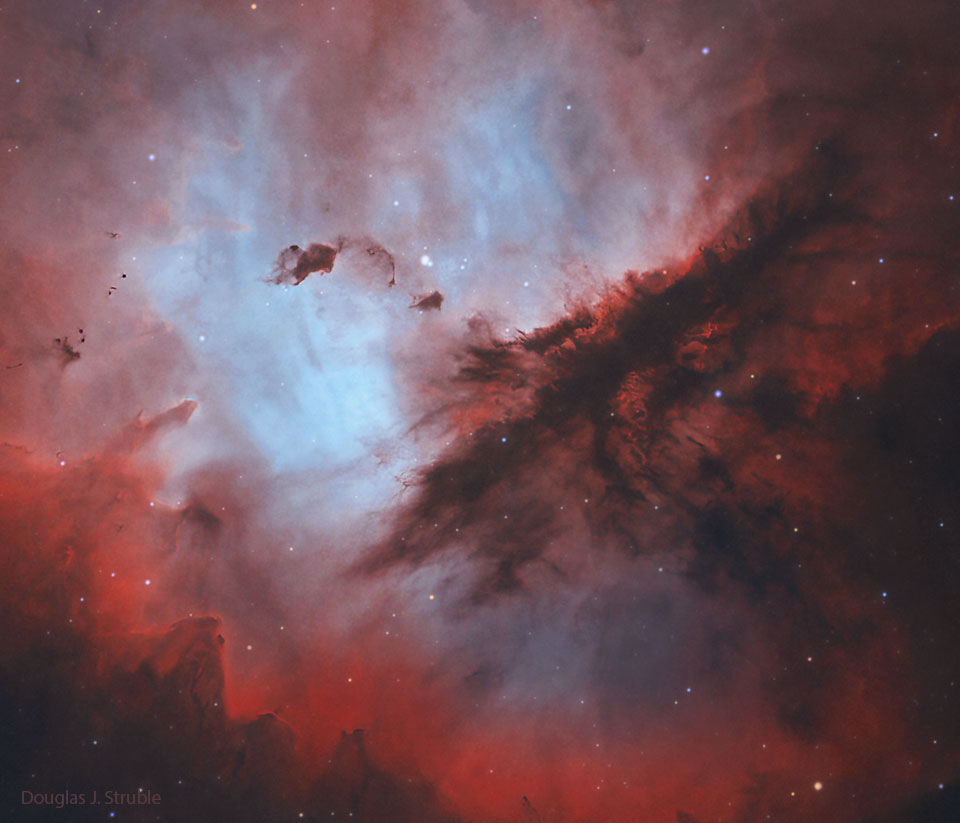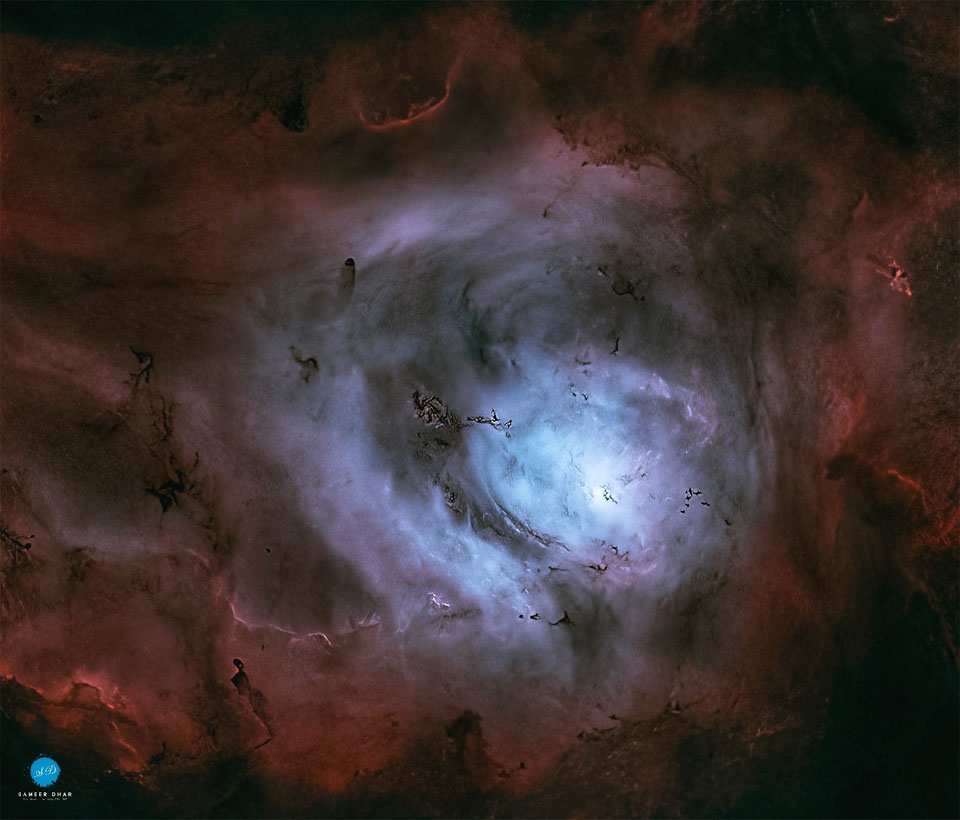Nombre total de pages vues
11/08/2022
ASTRONOMY - Perseids and MAGIC
2022 August 11
Image Credit & Copyright: Urs Leutenegger
Explanation: On August 11, 2021 a multi-mirror, 17 meter-diameter MAGIC telescope reflected this starry night sky from the Roque de los Muchachos European Northern Observatory on the Canary Island of La Palma. MAGIC stands for Major Atmospheric Gamma Imaging Cherenkov. The telescopes can see the brief flashes of optical light produced in particle air showers as high-energy gamma rays impact the Earth's upper atmosphere. To the dark-adapted eye the mirror segments offer a tantalizing reflection of stars and nebulae along the plane of our Milky Way galaxy. But directly behind the segmented mirror telescope, low on the horizon, lies the constellation Perseus. And on that date the dramatic composite nightscape also captured meteors streaming from the radiant of the annual Perseid meteor shower. This year the Perseid shower activity will again peak around August 13 but perseid meteors will have to compete with the bright light of a Full Moon.
10/08/2022
ASTRONOMY - Dust Clouds of the Pacman Nebula
2022 August 10
Image Credit & Copyright: Douglas J. Struble (Future World Media)
Explanation: Stars can create huge and intricate dust sculptures from the dense and dark molecular clouds from which they are born. The tools the stars use to carve their detailed works are high energy light and fast stellar winds. The heat they generate evaporates the dark molecular dust as well as causing ambient hydrogen gas to disperse and glow red. Pictured here, a new open cluster of stars designated IC 1590 is nearing completion around the intricate interstellar dust structures in the emission nebula NGC 281, dubbed the Pac-man Nebula because of its overall shape. The dust cloud on the upper left is classified as a Bok Globule as it may gravitationally collapse and form a star -- or stars. The Pacman Nebula lies about 10,000 light years away toward the constellation of Cassiopeia.
09/08/2022
SANTé/MéDECINE - Les vertus du cannabidiol (CBD)
ASTROPHOTOGRAPHIES - La nébuleuse de la Tête de Cheval
ASTRONOMY - Leaving Earth
022 August 9
Video Credit: NASA/JHU Applied Physics Lab/Carnegie Inst. Washington
Explanation: What it would look like to leave planet Earth? Such an event was recorded visually in great detail by the MESSENGER spacecraft as it swung back past the Earth in 2005 on its way in toward the planet Mercury. Earth can be seen rotating in this time-lapse video, as it recedes into the distance. The sunlit half of Earth is so bright that background stars are not visible. The robotic MESSENGER spacecraft is now in orbit around Mercury and has recently concluded the first complete map of the surface. On occasion, MESSENGER has continued to peer back at its home world. MESSENGER is one of the few things created on the Earth that will never return. At the end of its mission MESSENGER crashed into Mercury's surface.
08/08/2022
ASTRONOMY - The Lagoon Nebula without Stars
2022 August 8
Image Credit & Copyright: Sameer Dhar
Explanation: Ridges of glowing interstellar gas and dark dust clouds inhabit the turbulent, cosmic depths of the Lagoon Nebula. Also known as M8, the bright star forming region is about 5,000 light-years distant. But it still makes for a popular stop on telescopic tours of the constellation Sagittarius, toward the center of our Milky Way Galaxy. Dominated by the telltale red emission of ionized hydrogen atoms recombining with stripped electrons, this stunning, deep view of the Lagoon is nearly 100 light-years across. Right of center, the bright, compact, hourglass shape is gas ionized and sculpted by energetic radiation and extreme stellar winds from a massive young star. In fact, although digitally removed from the featured image, the many bright stars of open cluster NGC 6530 drift within the nebula, just formed in the Lagoon several million years ago.
07/08/2022
ASTRONOMY - Meteor before Galaxy
2022 August 7
Image Credit & Copyright: Fritz Helmut Hemmerich
Explanation: What's that green streak in front of the Andromeda galaxy? A meteor. While photographing the Andromeda galaxy in 2016, near the peak of the Perseid Meteor Shower, a small pebble from deep space crossed right in front of our Milky Way Galaxy's far-distant companion. The small meteor took only a fraction of a second to pass through this 10-degree field. The meteor flared several times while braking violently upon entering Earth's atmosphere. The green color was created, at least in part, by the meteor's gas glowing as it vaporized. Although the exposure was timed to catch a Perseid meteor, the orientation of the imaged streak seems a better match to a meteor from the Southern Delta Aquariids, a meteor shower that peaked a few weeks earlier. Not coincidentally, the Perseid Meteor Shower peaks later this week, although this year the meteors will have to outshine a sky brightened by a nearly full moon.
06/08/2022
MERVEILLEUX MONDE SOUS-MARIN - Souffleur à selle noire
ASTRONOMY - Full Moonlight
2026 January 3 Full Moonlight Image Credit & Copyright : Zhengjie Wu and Jeff Dai ( TWAN ) Explanation: The Full Moon is the brigh...

-
2022 September 26 All the Water on Planet Earth Illustration Credit: Jack Cook, Adam Nieman, Woods Hole Oceanographic Institution ; Data ...
-
2025 May 11 The Surface of Venus from Venera 14 Image Credit: Soviet Planetary Exploration Program , Venera 14 ; Processing & Copyri...






